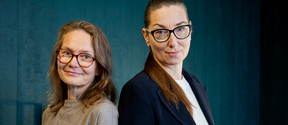Like a massive golf ball - Metsähovi Radio Observatory got a new radome
The Metsähovi Radio Observatory's landmark protects the telescope and enables year-round study of the Sun and black holes.

The extensive renovation of Aalto University's Metsähovi Radio Observatory, which took more than a year, is now complete. The oldest part of the observatory, built in the 1970s, was dismantled. An extension part, which was built in the 1990s, was renovated, and a completely new wing was built in connection with it. The new facilities include a room for meetings and seminars, workspaces, a kitchen, social facilities, and laboratory facilities.
In the renovation, building service technology was upgraded, and energy efficiency was significantly improved: for example, oil heating was replaced by environmentally friendly geothermal heating, more energy efficient windows were installed, ventilation was upgraded, and heat recovery was introduced.
‘We are eagerly waiting to continue our research work and teaching, and to receive guests in our upgraded facilities’, says Metsähovi Director Joni Tammi.
The Metsähovi Radio Observatory monitors, for example, radiation emanating from the sun and from black holes on every day of the year, and the renovation period was no exception.
‘Our technical team succeeded in ensuring that the equipment and observations also worked during the renovation, even though this required special arrangements of many kinds’, says laboratory engineer Juha Kallunki. For example, radio silence, which is in force over the entire area, was challenging for the contractors, because radio transmitters can be found in almost all types of construction machines nowadays.
Aalto University has invested heavily in the upgrading of Finland's only astronomical radio observatory and its research equipment in recent years. In a major operation last summer, the radar dome of Metsähovi's main research instrument, a 14-metre radio telescope, was replaced.
‘This is an indication that Aalto University also wants to invest in basic scientific research. The upgrades ensure that our activities and radio astronomy research in Finland can continue far into the future’, Joni Tammi says.

The Metsähovi Radio Observatory's landmark protects the telescope and enables year-round study of the Sun and black holes.

Astronomer Joni Tammi wants to uncover the secrets of the universe; secrets that have so far managed to elude us. However, with new advances in technology, the next major space discoveries are just around the corner.

Metsähovi Radio Observatory is the only astronomical radio observatory in Finland. Metsähovi’s main instrument is the 14-metre radio telescope, which is used around the clock, every day of the year. Its observational data is used, e.g., for studying active galaxies, the Sun, and the rotation of the Earth.



